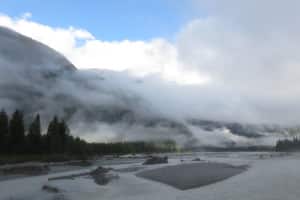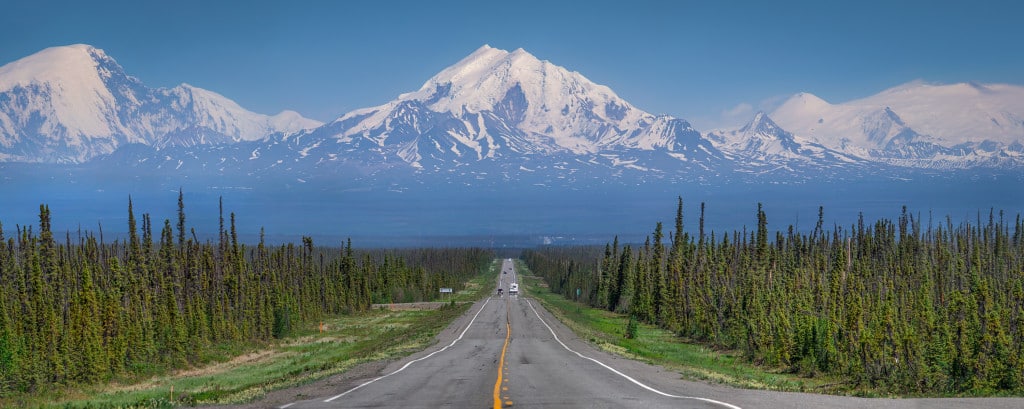A Road Trip To Alaska Introduction:
There’s something about a road trip to Alaska that inspires many people. It’s a dream, an item on the bucket list that many seek to accomplish some time in their life. There are thousands of folks out there who’ve become so overwhelmed by the journey that almost like a pilgrimage, year after year they faithfully return to the state. As a member of that club, it’s inspired me to help others find their way and hopefully make it more accessible to some that might have otherwise thought it too financially difficult or impossible.
 A road trip to Alaska can easily be one of the most expensive road trips you can take. Between the lodging, direct travel costs, food costs and the many incidentals, these expenses can easily get up to or exceed $10,000 quicker than anyone would like. There are a number of ways to save a ton of money on a road trip to Alaska, especially if you can be satisfied with tent camping. To do it comfortably and prepared will take a little investment up front, but it will still be a fraction of the cost of staying in hotels, lodges or hostels.
A road trip to Alaska can easily be one of the most expensive road trips you can take. Between the lodging, direct travel costs, food costs and the many incidentals, these expenses can easily get up to or exceed $10,000 quicker than anyone would like. There are a number of ways to save a ton of money on a road trip to Alaska, especially if you can be satisfied with tent camping. To do it comfortably and prepared will take a little investment up front, but it will still be a fraction of the cost of staying in hotels, lodges or hostels.
We explored a compromise between investing into quality, comfortable tent camping gear and minimizing lodging expenses. Even if you didn’t have a single piece of the gear we recommend, which probably isn’t the case, everything you need could be had for around a thousand dollars or less even less for the savvy shopper.
On the face of it, the challenge ahead is the thousands upon thousands of miles of driving time that it takes to do it. Put simply, it requires time and with higher fuel costs these days, a fair bit of money. Even with all the obstacles and seemingly impossible feats, since 1942, many thousands of people have made the journey from the mainland US to the great state of Alaska.
To assess whether an Alaska road trip is practical for you, consider these options:
- Do you have the means of taking a somewhat lengthy vacation? 3 weeks or more?
- Is it affordable? A minimum realistic budget is $3,000 and likely more!
- Do you have a vehicle that is, or can be, road worthy enough to make the journey?
- If your primary obstacle is financial, are you willing to invest your time and money to make things less expensive?
- Do you think you’re tolerant to a somewhat nomadic camping lifestyle for an extended period?
The reality is, for some who truly want to make this journey, it may take years to become ready enough, be it financially, vehicle-wise, time off for such a trip or whatever stands in your way. For many, though, the problem is the cost of the trip. An Alaska road trip shouldn’t be something relegated to a retirement dream, it could be your life’s pursuit at any age.
Fortunately, it doesn’t have to be that way if you can make some concessions on how you’ll actually travel. By cooking your own food, taking a less expensive vehicle (as in not a rented RV) and staying in low to no cost areas, you can cut out well over half of the expenses related to the trip. When you realize that the difference between nice, paid camping spots and even a basic hotel or cabin could save you well over $3,000, that removes obstacles for lot of people, ourselves included.
Is A Tent Camping Road Trip To Alaska Right For You?
This is a very good question to ask yourself. It might be a romantic notion for most people, but there is a big difference between talking or thinking about it and actually doing it. We’ve met so many people who say, “We’ve been talking about doing that forever!”
 The truth is, an Alaska road trip is an expensive venture no matter how you go about it. You might be the person willing to sleep in your car to absolutely minimize expense, but that doesn’t sound all that enjoyable to us for the length of a road trip like one to Alaska. With the right gear, it doesn’t have to be what anyone could even describe as uncomfortable, just maybe a little alternative.
The truth is, an Alaska road trip is an expensive venture no matter how you go about it. You might be the person willing to sleep in your car to absolutely minimize expense, but that doesn’t sound all that enjoyable to us for the length of a road trip like one to Alaska. With the right gear, it doesn’t have to be what anyone could even describe as uncomfortable, just maybe a little alternative.
As for camping along the way, there may be some concerns, especially if you’ve never done any nomadic camping before. If you don’t like camping to begin with, chances are very good you should just save some more money and choose to stay in a hotel, lodge or perhaps a hostel. Then again, if you’re good with telling yourself, “I’m OK with this because I’m saving a ridiculous amount of money,” then you might just persevere with that attitude. You might even find you enjoy it.
The road itself is a bit grueling, the vast distances can get to people who don’t appreciate a good, long road trip. Day after day, you will spend hours in your vehicle, traveling hundreds of miles at a time. Even when you get there, there’s likely little relief in that regard since you’ll still want to go see things and then you likely have another long drive home. There aren’t a ton of entertainment options along the way, at least in the vein of theme parks, fine dining and large cities to get lost in. Your view will be pretty, stunning at times, but there are also vast distances where all you can see are trees and road.
That’s truly the least of it, however. Nomadic camping is the practice of setting up and tearing down a camp, every morning and evening, until you arrive at your destination. It’s not your typical week-long camping trip that you enjoy on the lake or in the national forest somewhere. It can be exhausting and sometimes a challenge to your motivation, but it’s truly rewarding in the end. It does put a bit of a tax on your body and your mind, but it’s also exciting and fulfilling at the same time.
If you appreciate nature, outdoors and being in isolated areas, then chances are very good this trip is right for you. If northern culture, gold mining, fishing, hiking and other outdoor activities are your cup of tea, then an Alaska road trip is one of best places on earth to immerse yourself. If you love camping and like to do it at home when you can, you are likely a perfect candidate for a tent camping road trip. If the thought of waking up early and getting on the road thrills you, there’s little doubt you would enjoy every minute of it. If you’ve talked about it for years but just haven’t done it, we encourage you to get out of your shell and start down the path of actually doing it!
If you have children, that can add some more stress to the situation. Again, this isn’t your average road trip where, when they ask, “Are we there yet?” that you can offer any reasonable response. It’s not “a few hours” or “tomorrow morning.” No, the answer will have to be, “in a few days” or in some cases, “next week.” Children can most certainly enjoy this trip, but you have to be ready for it and assess whether it’s right for them as well as yourselves.
If you’re terrified of wild animals, you probably should realize that the likelihood of an attack is extremely low if you follow good bear safety. We can’t say it’s nonexistent, but it’s incredibly low, like being in a plane crash low. It’s certainly a reasonable fear however. If you take the proper precautions, such as having bear spray available in higher risk situations and maintaining vigilant bear safety practices, then it’s almost certain you’ll have a safe and enjoyable trip with no incidents to report.
How Long or Far Is A Road Trip To Alaska?
It’s probably important to assess the distances involved first. It’s hard for most of us to imagine the distances involved, but for most, this trip is nearly the same or more mileage as driving coast to coast and back again. From Seattle, Washington to Anchorage, Alaska is around 2,300 miles and it’s very likely that a round trip between those locations will crest well over 5,000 miles That doesn’t even include how far you are from the Canadian border!
 How do you even begin to estimate how much time you need?
How do you even begin to estimate how much time you need?
From the Canadian border, it’s roughly 2,000 miles to Tok, Alaska. That equates to roughly 40 driving hours, not including any stops for fuel, sightseeing or any other enjoyable activities. Theoretically, that could be driven in 2 to 3 days if you really pushed yourself, but a fast trip isn’t necessarily what would be recommended. It’s far more enjoyable to take your time on a journey like this and take reasonable, smaller steps each day. Four to seven days for this distance is a much more realistic pace and you will in enjoy it far more than a push to get there in a hurry.
An average road tripper, that generally wants a brisk but enjoyable pace, will usually be comfortable with an average of around 300 miles per day, which translates to about 4-5 hours of driving. If you really want to push it, you might be able to push that to 500 miles and still be comfortable, which is 7-8 hours of driving per day. Neither of those time estimates account for food stops, fuel stops or other sightseeing, so the lower end is usually more realistic. Do be careful not to get too optimistic with estimates here and exaggerate what you can actually do, since that might mean arriving back home later than expected.
You can certainly do more mileage and make up some time, but you’ll be driving a lot and not enjoying yourself very much. It’s feasibly possible to knock out a 1,000 miles in a day, but that doesn’t sound like fun at all and you won’t have any time to enjoy yourself. At that pace, you probably would just prefer to crash in a hotel and not establish a camp every night, but that’s up to you. It’s also certainly an effective strategy to extend your driving times in the mainland US/lower Canada to enjoy your time on the trip far north.
Figure out the number of miles between your departure point, the destinations that you’d like to visit and the return trip. You can use online mapping software for a fairly easy way to go or you can figure it out through a lot of extraneous research of maps and so forth. Divide that total by 300 or 500, whichever is your preferred amount of time on the road per day. That value is the least number of days it will take you to drive it. You really should add at least a few or more days to that travel time for tasks like grocery shopping and laundry, unexpected delays or just to stop and enjoy a place for a time.
For most who would take an Alaska road trip, you’ll want to spend a fair bit of time in Alaska when you get there. If you really just want to spend a few days in Alaska, you should just get a flight to make it easy on yourself. More likely, a week or more will be desirable to really get a vacation out of it. For reference, a whirlwind trip that takes you from Tok to Fairbanks, a brief stop in Denali National and State parks, on down to Anchorage, traversing the Kenai end to end with somewhat brief stops for most of the major towns took us about 10 days. It was brisk, but manageable and satisfying. If you can swing it, 14 days would likely be a perfect amount for a respectable expedition throughout the state, but the reality is for many of us, we have things that need tending back in the homeland.
Add those two estimates (driving time and time in Alaska) together and you basically have how much time you need for the trek. Some will have flexibility to take the amount of time required, and that’s great for them. Most folks, though, have jobs back at home. Taking a trip like this is a strain for many people younger in their years, not only because of the cost, but also because you’re either using up your vacation or going without pay entirely. These are all factors to consider in the planning stages.
It can add up to a substantial amount of time. Let’s not think about camping for that long of a period just yet, we’ll get there soon enough.
Is A Road Trip To Alaska Affordable?
 It really is important to consider the travel cost for a road trip of this size. It’s not every day you set out on a road trip of 5,000 to 10,000+ miles, so getting an idea of what it will cost in just fuel alone is important. Fuel will likely be your number one expense, depending on how much you spend on sightseeing, souvenirs and other activities along the way.
It really is important to consider the travel cost for a road trip of this size. It’s not every day you set out on a road trip of 5,000 to 10,000+ miles, so getting an idea of what it will cost in just fuel alone is important. Fuel will likely be your number one expense, depending on how much you spend on sightseeing, souvenirs and other activities along the way.
Earlier, we mentioned that the cost of a full-blown, 3 to 4 week road trip to Alaska can easily start to approach $10,000 or more. With a concerted effort and commitment to a tent camping road trip, your major expenses are truly just the direct travel expenses (fuel and campground fees) and incidental expenses like sightseeing and souvenirs, food costs and the occasional laundromat. You might have some expenses related to purchasing appropriate equipment for long distance tent camping, but you will then own the equipment and will save thousands in lodging on your road trip to Alaska.
In the above exercise, you figured out how many miles you’ll have to drive from your departure point to your desired destinations and back. Let’s figure out how much that’s going to cost in fuel! As you travel further north, fuel costs will rise dramatically, sometimes approaching 50% more than the mainland US. A very rough average can probably be ascertained by just saying somewhere around $5 a gallon. It’s better to estimate high here so you can actually get a realistic budget figure.
Take the number of travel miles you estimated above and divide it by the mile per gallon rating (or your estimated mile per gallon experience) that you’ll get from the vehicle you’ll take. That value is the number of gallons it will take to get you get to the places you want to go and back. Then, multiply that number by $5, and that will be your budgetary figure for fuel. Here’s an example:
- You estimate 8,500 miles to get there, go where you want and then home
- Your vehicle gets around 22 miles per gallon
- 8,500 miles / 22 miles per gallon = 386 gallons
- $5* 386 gallons = $1,930 in fuel expenses (add some additional for safety)
- Whoa! Why not just fly there for cheaper? Can be done, but you’ll miss out on 8,500 miles of the world’s most isolated, dramatic and beautiful country!
Obviously, the more fuel-efficient your vehicle is, the less impact there is to the travel cost! Most of the road to Alaska is paved these days, so there’s nothing that says you can’t bring a car, too. If you do, make sure you’re within your vehicle’s carry weight and take some care on the stretch between Whitehorse, Yukon and Tok, Alaska for the large section of frost heaves you’ll encounter there.
Other expenses are a little more difficult to predict, since it depends on what you want to do, how many people you’re feeding and what your overall travel budget actually is. In general, food costs are comparable to the mainland US in Canada, Yukon and Alaska, so you can use that as a relative reference. I would suggest starting at $500 per week as a good incidental budget, plus or minus a bit, but of course your situation could be entirely different.
Is Your Vehicle Ready For Road Trip To Alaska?
In the interest of not spending money on an RV, which is a considerable expense when it comes right down to it, you’re probably looking at taking one of your own vehicles on the trek. Taking a road trip to Alaska these days is not like the old days where you needed a 4×4 Jeep, dual spare tires and an expert mechanic on the trip to keep things running. Nonetheless, for most, there are a very large distances and some road challenges involved on an Alaska road trip. In your interests, you’ll want to properly assess your vehicle’s readiness to take on the journey and deal with any maintenance tasks that are desirable for the trip. Even to this day, there are sections of road along the Alaska routes that will punish your vehicle’s suspension, steering, tires, brakes and other critical systems. It’s important that things are up to the task!
We are not suggesting, at all, that you’ll need a newer vehicle to safely and reliably make the journey. But, there’s some things you probably should be paying attention to and we’ve created a special section just for this!

